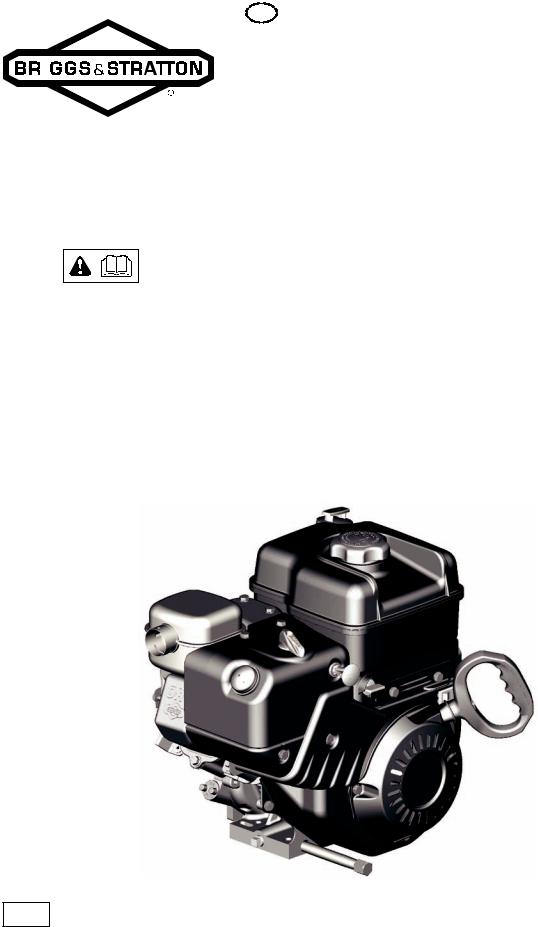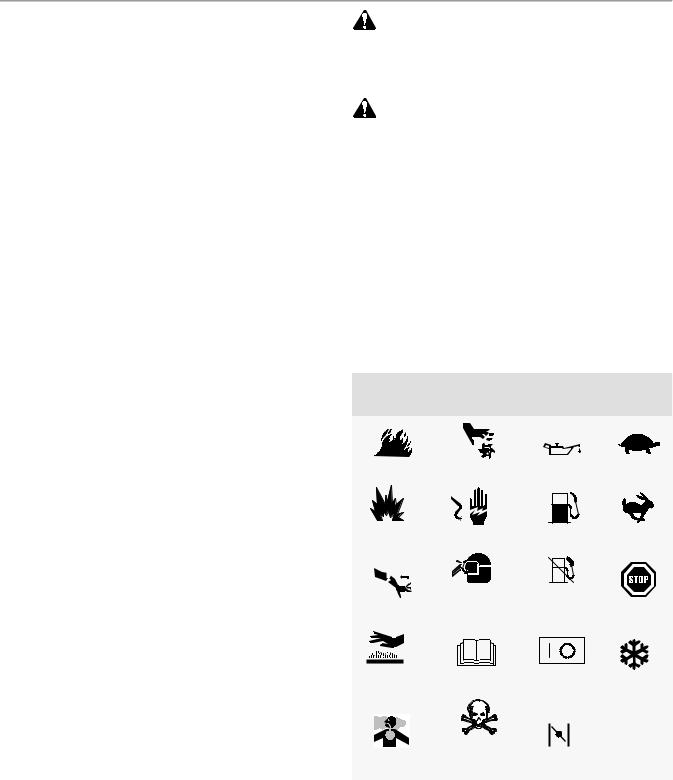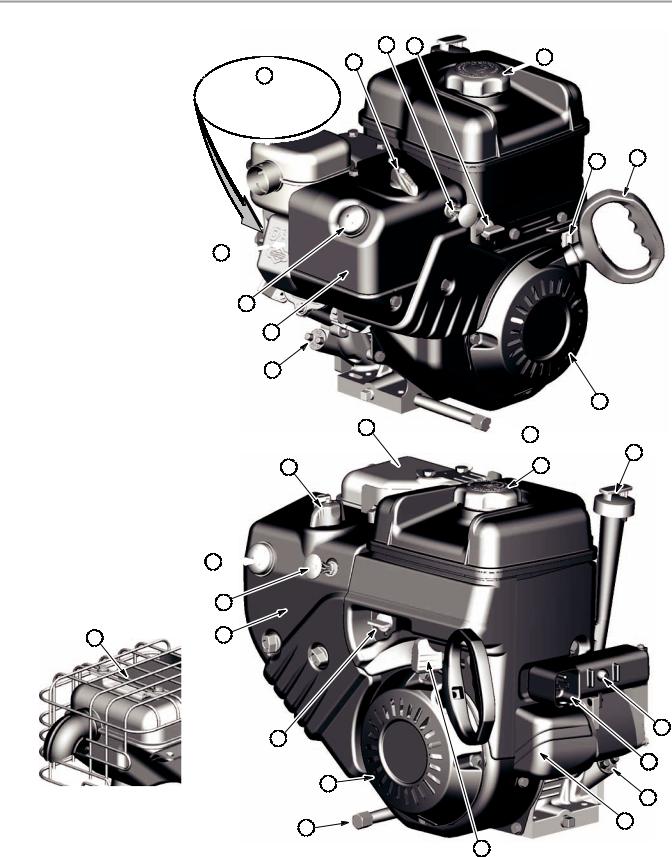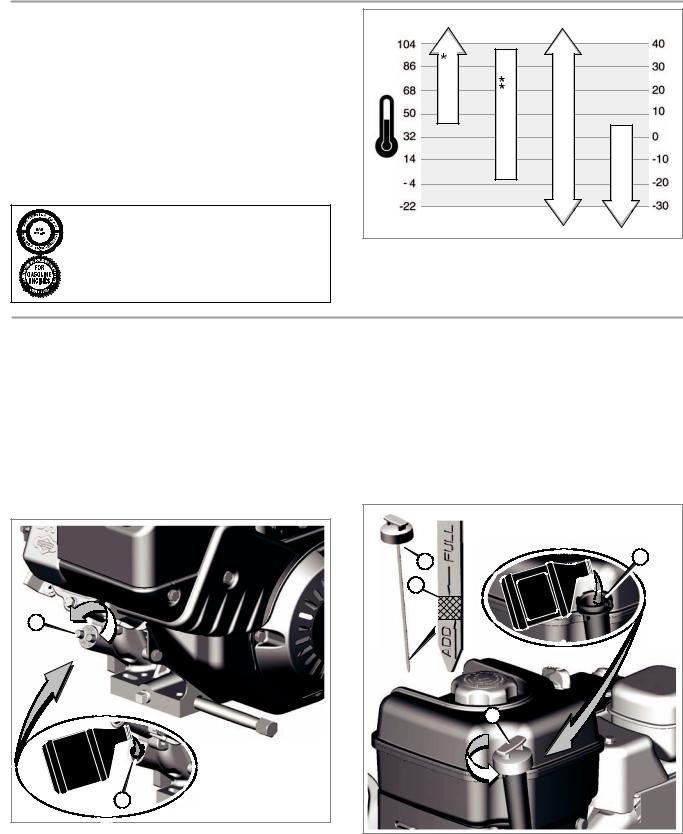Briggs & stratton 120000, 150000, 200000, 210000 Operating Manual

en Operator’s Manual
|
|
|
|
|
|
|
|
|
|
|
|
|
|
|
|
|
|
|
|
|
|
|
|
|
|
|
|
|
|
|
|
Model 120000 |
|
Snow Seriest |
|
|
|
||||
|
150000 |
|
Snow Series MAXt |
||
|
200000 |
|
|
|
|
|
210000 |
|
|
|
|
|
|
|
|
|
|
|
|
|
|
|
|
|
Form No. 277104WST-6/07 |
BRIGGSandSTRATTON.COM |
Printed in U.S.A. |
English |
|
en

Thank you for purchasing this quality-built Briggs & Stratton engine. We’re pleased that you’ve placed your confidence in the Briggs & Stratton brand. When operated and maintained according to the instructions in this manual, your Briggs & Stratton product will provide many years of dependable service.

 This manual contains safety information to make you aware of the hazards and risks associated with engines and how to avoid them. It also contains instructions for the proper use and care of the engine. Because Briggs & Stratton Corporation does not necessarily know what equipment this engine will power, it is important that you read and understand these instructions and the instructions for the equipment this engine powers. Save these instructions for future reference.
This manual contains safety information to make you aware of the hazards and risks associated with engines and how to avoid them. It also contains instructions for the proper use and care of the engine. Because Briggs & Stratton Corporation does not necessarily know what equipment this engine will power, it is important that you read and understand these instructions and the instructions for the equipment this engine powers. Save these instructions for future reference.
Where to Find Us
You never have to look far to find Briggs & Stratton service support for your engine. There are over 30,000 Briggs & Stratton authorized dealers worldwide who provide quality parts and service support. You can find your nearest service dealer by using our Dealer Locator at BRIGGSandSTRATTON.COM, or by calling Briggs & Stratton Customer Support at (800) 233-3723.
For replacement parts or technical assistance, record below the engine model, type, and code numbers along with the date of purchase. These numbers are located on your engine (see the Features and Controls page).
Date of purchase:
MM/DD/YYYY
Engine model:
Model: |
Type: |
Code: |
Table of Contents
Safety . . . . . . . . . . . . . . . . . . . . . . . . . . . . . . . . . . . . . . . . . . . . . . . 3
Features and Controls . . . . . . . . . . . . . . . . . . . . . . . . . . . . . . . . 6
Operation . . . . . . . . . . . . . . . . . . . . . . . . . . . . . . . . . . . . . . . . . . . . 7
Maintenance . . . . . . . . . . . . . . . . . . . . . . . . . . . . . . . . . . . . . . . 12
Troubleshooting . . . . . . . . . . . . . . . . . . . . . . . . . . . . . . . . . . . 18
Warranties . . . . . . . . . . . . . . . . . . . . . . . . . . . . . . . . . . . . . . . . . 19
Specifications . . . . . . . . . . . . . . . . . . . . . . . . . . . . . . . . . . . . . 21
Copyright E 2007 Briggs & Stratton Corporation, Milwaukee, WI, USA. All rights reserved. Printed in U.S.A.
Briggs & Stratton is a registered trademark of Briggs & Stratton Corporation
Milwaukee, WI, USA.
2 |
BRIGGSandSTRATTON.COM |

Operator Safety
General Information
This is a single cylinder, air-cooled engine. It is a low emissions engine.
In the state of California, Model 120000, 150000, 200000, 210000 engines are certified by the California Air Resources Board to meet emissions standards for 250 hours. Such certification does not grant the purchaser, owner or operator of this engine any additional warranties with respect to the performance or operational life of this engine. This engine is warranted solely according to the product and emissions warranties stated elsewhere in this manual.
Symbols And Warnings
The safety alert symbol  is used to identify safety information about hazards that can result in personal injury. A signal word (DANGER, WARNING, or CAUTION) is used with the alert symbol to indicate the likelihood and the potential severity of injury. In addition, a hazard symbol may be used to represent the type of hazard.
is used to identify safety information about hazards that can result in personal injury. A signal word (DANGER, WARNING, or CAUTION) is used with the alert symbol to indicate the likelihood and the potential severity of injury. In addition, a hazard symbol may be used to represent the type of hazard.
 DANGER indicates a hazard which, if not avoided, will result in death or serious injury.
DANGER indicates a hazard which, if not avoided, will result in death or serious injury.
 WARNING indicates a hazard which, if not avoided, could result in death or serious injury.
WARNING indicates a hazard which, if not avoided, could result in death or serious injury.
 CAUTION indicates a hazard which, if not avoided, might result in minor or moderate injury.
CAUTION indicates a hazard which, if not avoided, might result in minor or moderate injury.
CAUTION, when used without the alert symbol, indicates a situation that could result in damage to the product.
WARNING
The engine exhaust from this product contains chemicals known to the State of California to cause cancer, birth defects, or other reproductive harm.
WARNING
Briggs & Stratton does not approve or authorize the use of these engines on 3-wheel All Terrain Vehicles (ATVs), motor bikes, fun/recreational go-karts, aircraft products, or vehicles intended for use in competitive events. Use of these engines in such applications could result in property damage, serious injury (including paralysis), or even death.
CAUTION: This engine was shipped from Briggs & Stratton without oil. Before you start the engine, make sure you add oil according to the instructions in this manual. If you start the engine without oil, it will be damaged beyond repair and will not be covered under warranty.
SAFETY AND CONTROL SYMBOLS
Fire |
Moving Parts |
Oil |
Slow |
Explosion |
Shock |
Fuel |
Fast |
|
Wear Eye |
Fuel |
|
Kickback |
Protection |
Shutoff |
Stop |
Hot Surface |
Read Manual |
On Off |
Frostbite |
|
Hazardous |
|
|
Toxic Fumes |
Chemical |
Choke |
|
|
3 |
|
en |
||
|
||
|
|

Operator Safety
WARNING
Gasoline and its vapors are extremely
 flammable and explosive.
flammable and explosive.
Fire or explosion can cause severe burns or death.
When Adding Fuel
•Turn engine off and let engine cool at least 2 minutes before removing the fuel cap.
•Fill fuel tank outdoors or in well-ventilated area.
•Do not overfill fuel tank. Fill tank to approximately 1.5 inches (38 mm) below top of neck to allow for fuel expansion.
•Keep gasoline away from sparks, open flames, pilot lights, heat, and other ignition sources.
•Check fuel lines, tank, cap, and fittings frequently for cracks or leaks. Replace if necessary.
•If fuel spills, wait until it evaporates before starting engine.
When Starting Engine
•Ensure that spark plug, muffler, fuel cap and air cleaner are in place and secured.
•Do not crank engine with spark plug removed.
•If engine floods, set choke (if equipped) to OPEN/RUN position, move throttle (if equipped) to FAST position and crank until engine starts.
When Operating Equipment
•Do not tip engine or equipment at angle which causes gasoline to spill.
•Do not choke the carburetor to stop engine.
•Never start or run the engine with the air cleaner assembly or the air filter removed.
When Changing Oil
•If you drain the oil from the top oil fill tube, the fuel tank must be empty or fuel can leak out and result in a fire or explosion.
When Transporting Equipment
•Transport with fuel tank EMPTY or with fuel shut-off valve OFF.
When Storing Gasoline Or Equipment With
Fuel In Tank
•Store away from furnaces, stoves, water heaters or other appliances that have pilot light or other ignition source because they can ignite gasoline vapors.
WARNING
Starting engine creates sparking.
Sparking can ignite nearby flammable gases. Explosion and fire could result.
•If there is natural or LP gas leakage in area, do not start engine.
•Do not use pressurized starting fluids because vapors are flammable.
WARNING
Engines give off carbon monoxide, an odorless, colorless, poison gas.
Breathing carbon monoxide can cause nausea, fainting or death.
•Start and run engine outdoors.
•Do not start or run engine in enclosed area, even if doors or windows are open.
WARNING
Contents are HARMFUL OR FATAL IF
SWALLOWED. Avoid contact to eyes, skin, or clothing. Do not take internally. Avoid breathing the mist or vapor. Overexposure to eyes or skin can cause irritation. KEEP
STABILIZER OUT OF THE REACH OF
CHILDREN.
Fuel stabilizer is a hazardous chemical. **
•IF SWALLOWED, call physician immediately. Do not induce vomiting. If inhaled, remove to fresh air. In case of eye or skin contact, flush with water for 15 minutes.
•Store unopened cartridges in a cool, dry, well-ventilated area. Keep open cartridge in fuel cap and fuel cap closed on fuel tank when not in use.
**Fuel stabilizer contains: 2,6-di-tert-butylphenol (128-39-2) and aliphatic petroleum distillate (64742-47-8).
•In case of emergency, contact a physician immediately and call 1-800-424-9300 for material safety information.
4 |
BRIGGSandSTRATTON.COM |

Operator Safety
WARNING
Rapid retraction of starter cord (kickback) will pull hand and arm toward engine faster than
 you can let go.
you can let go.
Broken bones, fractures, bruises or sprains could result.
•When starting engine, pull the starter cord slowly until resistance is felt and then pull rapidly to avoid kickback.
•Remove all external equipment/engine loads before starting engine.
•Direct-coupled equipment components such as, but not limited to, blades, impellers, pulleys, sprockets, etc., must be securely attached.
WARNING
Rotating parts can contact or entangle hands,  feet, hair, clothing, or accessories.
feet, hair, clothing, or accessories.
Traumatic amputation or severe laceration can result.
•Operate equipment with guards in place.
•Keep hands and feet away from rotating parts.
•Tie up long hair and remove jewelry.
•Do not wear loose-fitting clothing, dangling drawstrings or items that could become caught.
WARNING
Running engines produce heat. Engine parts, especially muffler, become extremely hot.
Severe thermal burns can occur on contact.
Combustible debris, such as leaves, grass, brush, etc. can catch fire.
•Allow muffler, engine cylinder and fins to cool before touching.
•Remove accumulated debris from muffler area and cylinder area.
•Install and maintain in working order a spark arrester before using equipment on forest-covered, grass-covered, brush-covered unimproved land. The state of California requires this (Section 4442 of the California Public Resources Code). Other states may have similar laws. Federal laws apply on federal land.
WARNING
Unintentional sparking can result in fire or electric shock.
Unintentional start-up can result in entanglement, traumatic amputation, or
 laceration. Fire hazard
laceration. Fire hazard
 Before performing adjustments or repairs:
Before performing adjustments or repairs:
•Disconnect the spark plug wire and keep it away from the spark plug.
•Disconnect battery at negative terminal (only engines with electric start.)
•Use only correct tools.
•Do not tamper with governor spring, links or other parts to increase engine speed.
•Replacement parts must be the same and installed in the same position as the original parts.
•Do not strike the flywheel with a hammer or hard object because the flywheel may later shatter during operation.
When testing for spark:
•Use approved spark plug tester.
•Do not check for spark with spark plug removed.
|
5 |
|
en |
||
|
||
|
|

Features and Controls
A.Engine Identification
Model Type Code
B.Spark Plug
C.Choke
D.Primer
E.Fuel Shut-off Valve
F.Starter Cord Handle
G.Finger Guard
H.Stop Switch (optional)
I.Fuel Tank and Cap
J.Oil Fill Cap
K.Dipstick/Oil Fill
L.Oil Drain Plug
M.Muffler
Muffler Guard (optional) Muffler Deflector
N.Safety Key
O.Push Button Electric Start
P.Snow Hood
Q.Power Cord Receptacle
R.Electric Starter
S.Throttle Control (optional)
M
N E
A
C  I
I
Engine Identification
Model Type Code
H F
B
D
P
J
G
M  L
L
K
C  I
I
D 
N
P
O
E
|
Q |
|
G |
|
J |
L |
R |
|
|
|
S |
6 |
BRIGGSandSTRATTON.COM |

Oil Capacity
Oil capacity (see the Specifications section)
Oil Recommendations
We recommend the use of Briggs & Stratton Warranty Certified oils for best performance. Other high-quality detergent oils are acceptable if classified for service SF, SG, SH, SJ or higher. Do not use special additives.
Outdoor temperatures determine the proper oil viscosity for the engine. Use the chart to select the best viscosity for the outdoor temperature range expected.
Note: Synthetic oil meeting ILSAC GF-2, API certification mark and API service symbol (shown at left) with “SJ/CF ENERGY CONSERVING” or higher, is an acceptable oil at all temperatures. Use of synthetic oil does not alter required oil change intervals.
Operation
°F |
°C |
SAE 30 |
-30 |
5W-30 |
|
|
10W |
Synthetic |
5W-30 |
*Below 40°F (4°C) the use of SAE 30 will result in hard starting.
**Above 80°F (27°C) the use of 10W-30 may cause increased oil consumption. Check oil level more frequently.
How To Check/Add Oil
Before adding or checking the oil
•Place engine level.
•Clean the oil fill area of any debris.
Models with oil fill cap (Figure 1)
1.Remove the oil fill cap (A).
2.To add oil, pour the oil slowly into the engine oil fill (B). Fill to point of overflowing.
3.Replace and tighten the oil fill cap.
A
B
Figure 1
Models with extended dipstick (Figure 2)
1.Remove the dipstick (C) and wipe with a clean cloth.
2.Insert and tighten the dipstick.
3.Remove the dipstick and check the oil level. Make sure the oil is at the FULL mark (D) on the dipstick.
4.To add oil, pour the oil slowly into the engine oil fill (B). Do not overfill. After adding oil, wait one minute and then recheck the oil level.
5.Fill to the FULL mark (D) on the dipstick.
6.Replace and tighten the dipstick.
C |
B |
|
|
D |
|
|
C |
Figure 2
|
7 |
|
en |
||
|
||
|
|
